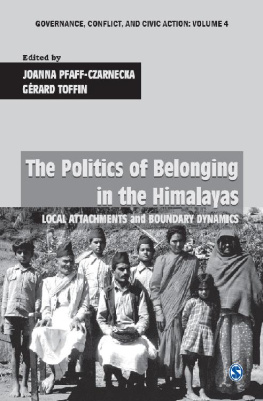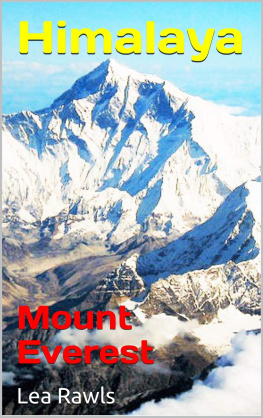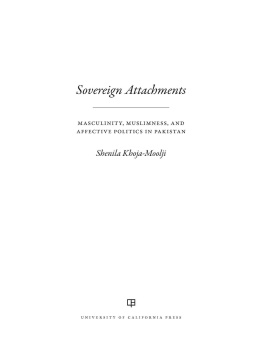Joanna Pfaff-Czarnecka - The Politics of Belonging in the Himalayas: Local Attachments and Boundary Dynamics
Here you can read online Joanna Pfaff-Czarnecka - The Politics of Belonging in the Himalayas: Local Attachments and Boundary Dynamics full text of the book (entire story) in english for free. Download pdf and epub, get meaning, cover and reviews about this ebook. year: 2011, publisher: SAGE Publications, genre: Politics. Description of the work, (preface) as well as reviews are available. Best literature library LitArk.com created for fans of good reading and offers a wide selection of genres:
Romance novel
Science fiction
Adventure
Detective
Science
History
Home and family
Prose
Art
Politics
Computer
Non-fiction
Religion
Business
Children
Humor
Choose a favorite category and find really read worthwhile books. Enjoy immersion in the world of imagination, feel the emotions of the characters or learn something new for yourself, make an fascinating discovery.
- Book:The Politics of Belonging in the Himalayas: Local Attachments and Boundary Dynamics
- Author:
- Publisher:SAGE Publications
- Genre:
- Year:2011
- Rating:3 / 5
- Favourites:Add to favourites
- Your mark:
- 60
- 1
- 2
- 3
- 4
- 5
The Politics of Belonging in the Himalayas: Local Attachments and Boundary Dynamics: summary, description and annotation
We offer to read an annotation, description, summary or preface (depends on what the author of the book "The Politics of Belonging in the Himalayas: Local Attachments and Boundary Dynamics" wrote himself). If you haven't found the necessary information about the book — write in the comments, we will try to find it.
The Politics of Belonging in the Himalayas: Local Attachments and Boundary Dynamics — read online for free the complete book (whole text) full work
Below is the text of the book, divided by pages. System saving the place of the last page read, allows you to conveniently read the book "The Politics of Belonging in the Himalayas: Local Attachments and Boundary Dynamics" online for free, without having to search again every time where you left off. Put a bookmark, and you can go to the page where you finished reading at any time.
Font size:
Interval:
Bookmark:

Half Title
The Politics of Belonging
in the Himalayas
Series Note
Governance, Conflict, and Civic Action Series
Series Editors: David N. Gellner, Krishna Hachhethu, Siri Hettige, Joanna Pfaff-Czarnecka, Grard Toffin
Volume 1: Local Democracy in South Asia: Microprocesses of Democratization in Nepal and its Neighbours , eds David N. Gellner and Krishna Hachhethu
Volume 2: Ethnic Activism and Civil Society in South Asia , ed. David N. Gellner
Volume 3: Varieties of Activist Experience: Civil Society in South Asia , ed. David N. Gellner
Volume 4: The Politics of Belonging in the Himalayas: Local Attachments and Boundary Dynamics , eds Joanna Pfaff-Czarnecka and G rard Toffin
Volumes in Preparation
Development, Governance and Conflict in South Asia , eds Siri Hettige and Eva Gerharz
Facing Globalization in the Himalayas: Belonging and the Politics of the Self , eds Joanna Pfaff-Czarnecka and G rard Toffin
This volume has been produced with the financial assistance of the European Union (EU). The contents of the book are the sole responsibility of the respective authors and can under no circumstances be regarded as reflecting the position of the EU.
The Asia-Link Programme was launched at the beginning of 2002 as an initiative by the EU to foster regional and multilateral networking between higher education institutions in EU Member States and South Asia, South-East Asia, and China. This five-year programme, which has a total budget of 42.8 million, aims to provide support to European and Asian higher education institutions in the areas of human resource development, curriculum development, and institutional and systems development.
The Politics of Belonging in the
Himalayas: Local Attachments
and Boundary Dynamics
GOVERNANCE, CONFLICT, AND CIVIC ACTION: VOLUME 4
Edited by
Joanna Pfaff-Czarnecka
Grard Toffin

C opyright Joanna Pfaff-Czarnecka and Grard Toffin, 2011
All rights reserved. No part of this book may be reproduced or utilized in any form or by any means, electronic or mechanical, including photocopying, recording or by any information storage or retrieval system, without permission in writing from the publisher.
First published in 2011 by

Sage Publications India Pvt Ltd
B1/I-1 Mohan Cooperative Industrial Area
Mathura Road, New Delhi 110 044, India
www.sagepub.in
Sage Publications Inc
2455 Teller Road
Thousand Oaks, California 91320, USA
Sage Publications Ltd
1 Olivers Yard, 55 City Road
London EC1Y 1SP, United Kingdom
Sage Publications Asia-Pacific Pte Ltd
33 Pekin Street
#02-01 Far East Square
Singapore 048763
Published by Vivek Mehra for Sage Publications India Pvt Ltd, Phototypeset in 10/12pt Sabon by Star Compugraphics Private Limited, Delhi and printed at Chaman Enterprises, New Delhi.
Library of Congress Cataloging-in-Publication Data
The politics of belonging in the Himalayas: local attachments and boundary dynamics/edited by Joanna Pfaff-Czarnecka , Grard Toffin.
p. cm(Governance, conflict, and civic action series; v. 4)
Includes bibliographical references and index.
Ethnic groupsHimalaya Mountains Region. 2. Group identity Himalaya Mountains Region. 3. NationalismHimalaya Mountains Region. 4. National characteristics. 5. Himalaya Mountains RegionEthnic relations. I. Pfaff-Czarnecka, Joanna. II. Toffin, Grard.
DS485.H6P65 305.80095496dc22 2011 2011007105
eISBN: 9788132107729
The Sage Team: Rekha Natarajan, Arpita Dasgupta, Amrita Saha and Deepti Saxena
Cover caption: Brahmin extended family, central hill region of Nepal (1980).
Photo courtesy: Joanna Pfaff-Czarnecka
Contents
Introduction : Belonging and Multiple Attachments in
Contemporary Himalayan Societies
Politics of Belonging: Identity and State-formation
in Nagaland
Brotherhood and Divine Bonding in the
Krishna Pranami Sect
Religion, Rituals, and Symbols of Belonging:
The Case of Uttarakhand
The Politics of Encounter: Hindu Belonging in a Multi-faith
Pilgrimage Site in Nepal
Emergent Nationalism, Citizenship, and Belonging among
Nepalis in Banaras: The Case of Kashi Bahadur Shrestha
Pathways of Place Relation: Moving Contours of
Belonging in Central Nepal
Belonging, Protected Areas, and Participatory Management:
The Case of Kaziranga National Park (Assam) and
of the Misings Shifting Territory
Geocultural Identities and Belonging in the Ethnohistory of
Central Himalaya, Uttarakhand, India
Trials, Witnesses, and Local Stakes in a District Court of
Himachal Pradesh
For our Readers
Thank you for choosing a SAGE product! If you have any comment, observation or feedback, I would like to personally hear from you Please write to me at contactceo@sagepub.in
Vivek Mehra, Managing Director and CEO,
SAGE Publications India Pvt Ltd, New Delhi
Bulk Sales
SAGE India offers special discounts for purchase of books in bulk. We also make available special imprints and excerpts from our books on demand.
For orders and enquiries, write to us at
Marketing Department
SAGE Publications India Pvt Ltd
B1/I-1, Mohan Cooperative Industrial Area
Mathura Road, Post Bag 7
New Delhi 110044, India
E-mail us at marketing@sagepub.in
Get to know more about SAGE, be invited to SAGE events, get on our mailing list. Write today to marketing@sagepub.in

This volume, The Politics of Belonging in the Himalayas: Local Attachments and Boundary Dynamics , is the outcome of an inter-national conference that took place in New Delhi during 2022 March 2007. All the chapters contained in the book developed out of the presentations during this scientific meeting. Our thanks go the India International Centre, New Delhi, which supported and housed this event, and to the French Centre for Human Sciences, Delhi, and in particular to its then director, Vronique Dupont, as well as to Mallika Hanif and Romain Chappuis, each of whom played a major role in organizing the conference. We are also indebted to our Indian colleagues from Jawaharlal Nehru University, Institute of Economic Growth, and other academic institutes in Delhi, who agreed to par-ticipate in the meeting as discussants and greatly contributed to the debate on the concept of belonging. We would like to list all of them here: Ravina Aggarwal, Balveer Arora, Amita Baviskar, Nirja Gopal Jayal, Surinder Jodhka, Ravinder Kaur, and Patricia Oberoi. We would also like to express our thanks to Andre Gingrich from the University of Vienna, Nirmal Tuladhar from Tribhuvan Univer-sity (Nepal), Christian Bueschges from the University of Bielefeld, and Kanak Dixit of Himal Association for their stimulating role as discussants.
This undertaking would not have been possible without the sup-port of the German Research Foundation (DFG) through its Collab-orative Research Programme (SFB 584) carried out at the Bielefeld University, Germany, the European EU-Asia-Link programme of the European Commission (Brussels), the British Academy, the French National Centre for Scientific Research (CNRS), and the French foundation Maison des Sciences de lHomme (MSH), Paris. Professor Hinnerk Bruhns (MSH), in particular, warmly encouraged the project from the very beginning and has given us useful advice and suggestions for its organization. We are grateful to David Gellner, University of Oxford, who invited us to include this book in MIDEA series, published by SAGE Publications. Finally, our thanks are due to Bernadette Sellers (CNRS, Villejuif) who revised the papers written by French researchers, and to David Phelps (Oxford) and Pragya Dhital (London), who edited the final English versions of the book.
Font size:
Interval:
Bookmark:
Similar books «The Politics of Belonging in the Himalayas: Local Attachments and Boundary Dynamics»
Look at similar books to The Politics of Belonging in the Himalayas: Local Attachments and Boundary Dynamics. We have selected literature similar in name and meaning in the hope of providing readers with more options to find new, interesting, not yet read works.
Discussion, reviews of the book The Politics of Belonging in the Himalayas: Local Attachments and Boundary Dynamics and just readers' own opinions. Leave your comments, write what you think about the work, its meaning or the main characters. Specify what exactly you liked and what you didn't like, and why you think so.









